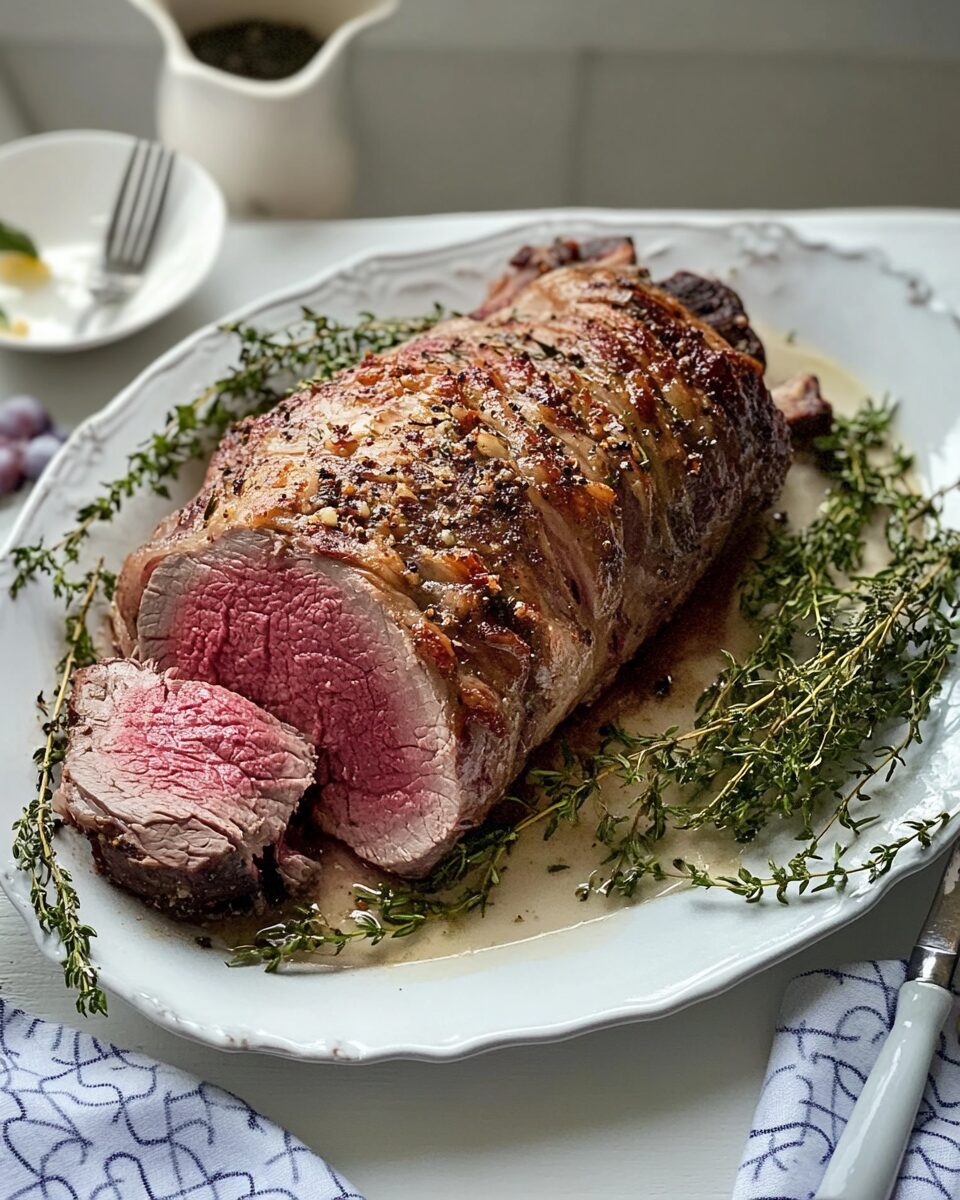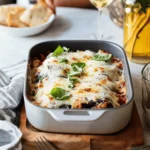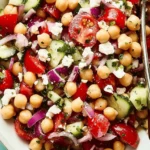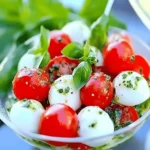This Easter Leg of Lamb recipe offers a flavorful and tender roast, perfect for holiday gatherings. The lamb is marinated in a mixture of yogurt, fresh herbs, garlic, and lemon zest, then roasted to perfection atop a bed of onions.
FULL RECIPE:
Ingredients
For the Marinade:
- 1 (16-ounce) container plain yogurt
- 4 sprigs fresh rosemary, leaves stripped
- ½ bunch fresh parsley, stems removed
- ½ head garlic, peeled and smashed
- Zest of 1½ lemons
For the Roasted Lamb:
- 1 (3-pound) boneless leg of lamb
- 2 large onions, quartered
- ¼ cup olive oil
- 4 sprigs fresh rosemary, leaves stripped
- 3 tablespoons kosher salt
- 3 tablespoons ground black pepper
- ½ bunch fresh parsley, stems removed
- ½ head garlic
- Zest of 1½ lemons
Directions
- Prepare the Marinade: In a large glass or ceramic bowl, combine the yogurt, rosemary leaves, parsley leaves, smashed garlic, and lemon zest. Mix well.
- Marinate the Lamb: Add the boneless leg of lamb to the marinade, ensuring it is thoroughly coated. Cover the bowl with plastic wrap and refrigerate for 24 to 48 hours to allow the flavors to meld.
- Preheat the Oven: When ready to roast, preheat your oven to 400°F (200°C).
- Prepare the Roasting Pan: Spread the quartered onions evenly across the bottom of a roasting pan.
- Prepare the Lamb: Remove the lamb from the marinade. Rinse under cold water and pat dry with paper towels. Discard the used marinade.
- Make the Herb Paste: In a food processor, combine the olive oil, rosemary leaves, kosher salt, black pepper, parsley leaves, garlic, and lemon zest. Pulse until the mixture forms a smooth paste.
- Season the Lamb: Rub the herb paste evenly over the surface of the lamb, ensuring all sides are well-coated.
- Roast the Lamb: Place the seasoned lamb on top of the bed of onions in the roasting pan. Roast in the preheated oven until the internal temperature reaches your desired level of doneness (typically 130°F (54°C) for medium-rare), approximately 75 to 90 minutes.
- Rest the Meat: Once roasted, remove the lamb from the oven and let it rest for about 20 minutes before slicing. This allows the juices to redistribute throughout the meat, ensuring a moist and tender roast.
Nutrients
- Calories: 707
- Total Fat: 49g (63% Daily Value)
- Saturated Fat: 19g (95% DV)
- Cholesterol: 161mg (54% DV)
- Sodium: 3073mg (134% DV)
- Total Carbohydrates: 22g (8% DV)
The History and Significance of Easter Leg of Lamb
The tradition of serving lamb for Easter dates back thousands of years and is deeply rooted in religious and cultural practices. In Christian tradition, lamb symbolizes Jesus Christ, often referred to as the “Lamb of God.” This symbolism comes from the Jewish Passover, where lamb was sacrificed and eaten as part of the celebration. Over time, as Christianity spread across Europe, the tradition of serving lamb at Easter became widely adopted. In many cultures, lamb is considered a dish of celebration, served during special occasions and holidays. The use of fresh herbs and seasonings, like rosemary, garlic, and lemon, has evolved from Mediterranean culinary traditions, enhancing the natural flavors of the meat. Today, Easter Leg of Lamb is a beloved dish in various countries, particularly in Europe and the United States.
Why This Recipe Stands Out
The Easter Leg of Lamb recipe is unique due to its use of a yogurt-based marinade, which tenderizes the meat and infuses it with deep, aromatic flavors. Unlike traditional dry rubs, the yogurt allows the flavors to penetrate the meat more effectively, resulting in a juicy and flavorful roast. The addition of fresh herbs like rosemary and parsley enhances the natural taste of the lamb, while garlic and lemon zest add brightness to the dish. Another standout feature of this recipe is the use of roasted onions, which add a caramelized sweetness to balance the richness of the lamb. This combination of ingredients makes the dish well-rounded and suitable for a festive Easter dinner.
Pairing Suggestions for Easter Leg of Lamb
To create a complete Easter meal, consider pairing this dish with complementary sides and beverages. Here are some excellent choices:
- Side Dishes: Roasted potatoes, honey-glazed carrots, sautéed green beans, asparagus with lemon butter, or a fresh garden salad.
- Sauces: Mint sauce, tzatziki, or a rich red wine reduction can enhance the flavors of the lamb.
- Bread: A crusty artisan loaf or garlic-rosemary focaccia pairs well with the dish.
- Wine Pairing: A bold red wine like Cabernet Sauvignon, Merlot, or Syrah complements the richness of the lamb.
- Desserts: End the meal with a light dessert like lemon tart, baklava, or a classic Easter cake.
Tips for Cooking the Perfect Easter Leg of Lamb
- Choosing the Right Cut: A boneless leg of lamb is easier to handle and cook evenly, while a bone-in leg adds extra flavor. Decide based on your preference.
- Marination Time: Allow the lamb to marinate for at least 12 hours, preferably overnight, to achieve the best flavor and tenderness.
- Cooking Temperature: Roasting the lamb at a high temperature first helps create a beautiful crust, then reducing the heat ensures even cooking.
- Resting the Meat: Always let the lamb rest for 15-20 minutes before carving to retain its juices and keep it tender.
- Use a Meat Thermometer: To achieve the desired doneness, use a thermometer: 135°F for medium-rare, 145°F for medium, and 155°F for well-done.
Health Benefits of Lamb
Lamb is a nutritious source of protein, packed with essential vitamins and minerals. Some key benefits include:
- High-Quality Protein: Lamb provides all the essential amino acids necessary for muscle growth and repair.
- Rich in Iron: It contains heme iron, which is more easily absorbed by the body compared to plant-based iron sources.
- Vitamin B12: Essential for brain function and red blood cell production, lamb is an excellent source of this vital nutrient.
- Zinc and Selenium: These minerals support the immune system and contribute to overall health.
- Healthy Fats: While lamb contains saturated fat, it also has monounsaturated fats that can be beneficial when consumed in moderation.
Cultural Variations of Easter Lamb
Lamb dishes vary widely across cultures, reflecting different culinary traditions:
- Greek Easter Lamb: Often spit-roasted and seasoned with garlic, lemon, and oregano.
- French Gigot d’Agneau: A slow-roasted leg of lamb seasoned with mustard, garlic, and herbs.
- Italian Easter Lamb: Usually braised or roasted with rosemary, white wine, and tomatoes.
- Middle Eastern Lamb: Cooked with fragrant spices like cumin, coriander, and cinnamon, sometimes served with rice or flatbread.
Conclusion
Easter Leg of Lamb is more than just a holiday dish—it represents tradition, history, and the joy of sharing a meal with loved ones. This particular recipe stands out for its flavorful marinade, aromatic herbs, and perfectly roasted texture. By pairing it with delicious sides and following cooking tips, you can create a memorable Easter feast that delights your family and guests. Whether you stick to tradition or add your own twist, this dish remains a timeless centerpiece for Easter celebrations.






